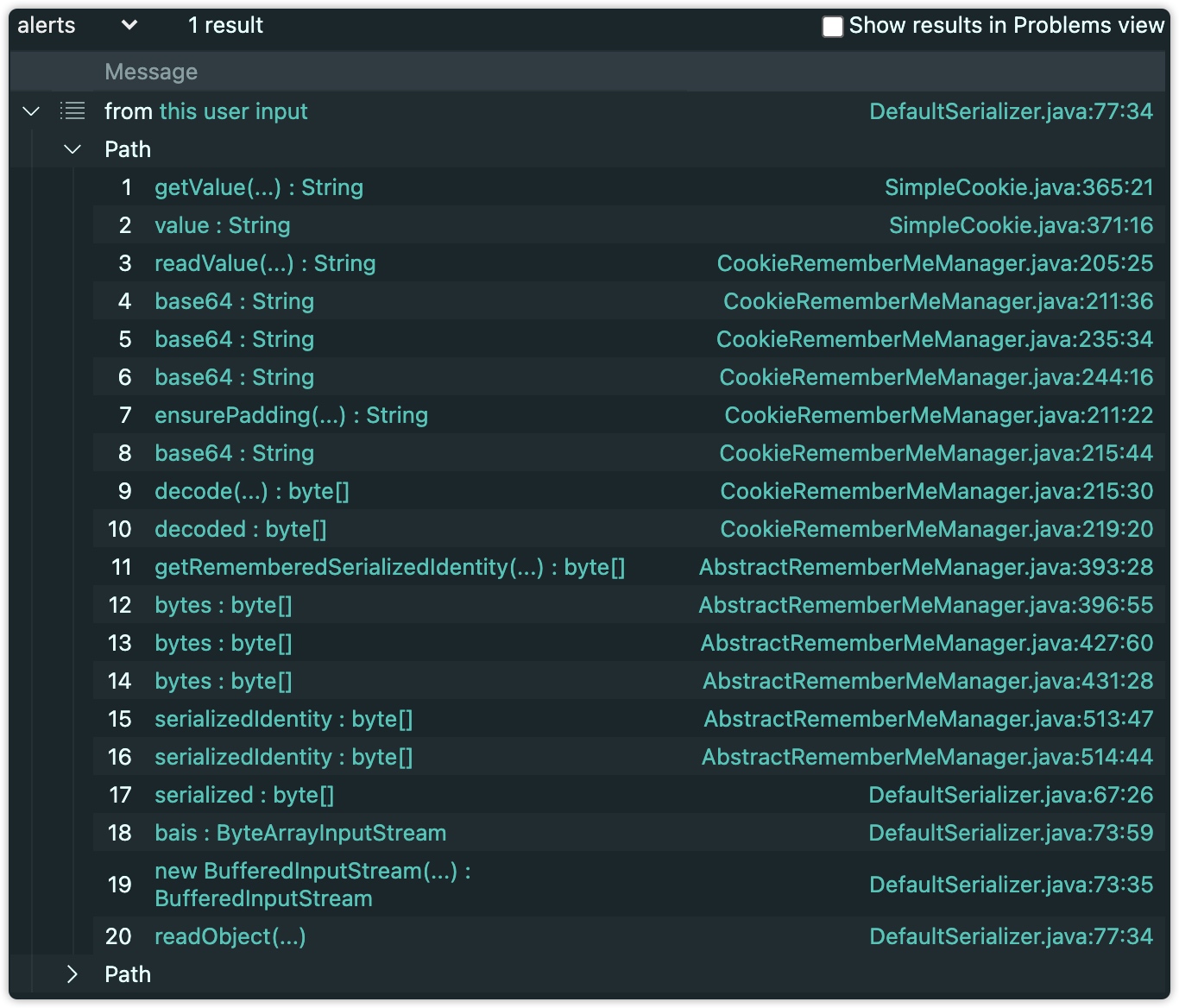FastJson JNDI 分析
方向
首先,我们先要明确现在是已知漏洞点和步入条件,由此来尝试获取其他未知的链
比如需要满足以下条件的setter
- 函数名长度 >= 4
- 非静态函数
- 返回类型要么是void要么是当前类
- 参数只有一个
- 方法名需要以set开头
----
满足以下条件的getter
- 函数名长度 >= 4
- 非静态函数
- 函数名称以get起始,且第四个字符为大写字母
- 函数没有入参
- 继承自Collection || Map || AtomicBoolean || AtomicInteger || AtomicLong首先编译好数据库,然后开始着手 QL 查询文件
QL
I. 定义 JNDI 相关方法
第一步,由于我们目标 sink 是 JNDI 相关类下的 lookup 方法,所以先定义目标方法
class JNDIMethod extends Method {
JNDIMethod() {
this.getDeclaringType().hasQualifiedName("javax.naming", "Context") and
this.hasName("lookup")
}
}来解释下各行的内容,之后的学习就不再赘述
- Line 1: 首先自定义的类要继承 Codeql 提供的 Method 类,用于遴选出我们想要的方法
- Line 3、4: 这两行的作用即满足这些
限制条件,那么this应是我们想要的方法
其中,对限制条件中用到的函数做一些解释
- Member::getDeclaringType -> RefType 获取定义当前方法的类
- RefType::getAnAncestor -> RefType 获取当前类的直接或间接父类,包括其自身
- Member::hasQualifiedName -> predicate 获取在此类在指定 package 中以指定 name 声明
所以整个限制条件直接翻译就是:寻找名为 lookup 的方法所在类,且此类应在javax.naming中被声明为Context类,即查找 javax.naming.Context#lookup
class JNDIMethod extends Method {
JNDIMethod() {
this.getDeclaringType().hasQualifiedName("javax.naming", "Context") and
this.hasName("lookup")
}
}II. 设定(全局)污点跟踪
Source
函数解释
- FieldAccesses::getSite -> Callable 获取当前字段所在表达式的直接封闭可调用对象(细品
- Element::getName -> string 获取当前元素的命名
isSource 检测是否存在某个对字段的访问的表达式,是在名为 getXXX 或 setXXX 的函数中,是的话则将此字段入口设置为搜寻的 source(起点)
override predicate isSource(DataFlow::Node node) {
exists(FieldAccess fac | (
fac.getSite().getName().indexOf("get") = 0 or
fac.getSite().getName().indexOf("set") = 0
) and node.asExpr() = fac
)
}Sink
函数解释
- MethodAccess::getMethod -> Method 返回当前方法入口的方法(绕口
isSink 检测是否存在某个方法是 JNDIMethod 的实例,且第一个参数可控,是的话将此方法入口设置为搜寻的 sink(终点)
override predicate isSink(DataFlow::Node node) {
exists(MethodAccess md | (
md.getMethod() instanceof JNDIMethod and
node.asExpr() = md.getArgument(0)
)
)
}III. 执行搜索
说实话看官方文档没太看懂 DataFlow DataFlow2 有啥区别
- Configuration::hasFlowPath -> predicate 获取满足从 source 流向 sink 的数据
from MyTaintTraking conf, DataFlow2::PathNode source, DataFlow2::PathNode sink
where conf.hasFlowPath(source, sink)
select ...Metadata 设置
/**
* @kind path-problem
*/
import java
import semmle.code.java.dataflow.FlowSources
import semmle.code.java.dataflow.TaintTracking2
import DataFlow2::PathGraph
class JNDIMethod extends Method {
JNDIMethod() {
this.getDeclaringType().hasQualifiedName("javax.naming", "Context") and
this.hasName("lookup")
}
}
class MyTaintTraking extends TaintTracking2::Configuration {
MyTaintTraking() { this = "MyTaintTraking" }
override predicate isSource(DataFlow::Node node) {
exists(FieldAccess fac | (
fac.getSite().getName().indexOf("get") = 0 or
fac.getSite().getName().indexOf("set") = 0
) and node.asExpr() = fac
)
}
override predicate isSink(DataFlow::Node node) {
exists(MethodAccess md | (
md.getMethod() instanceof JNDIMethod and
node.asExpr() = md.getArgument(0)
)
)
}
}
from MyTaintTraking conf, DataFlow2::PathNode source, DataFlow2::PathNode sink
where conf.hasFlowPath(source, sink)
select sink.getNode(), source, sink, "JNDI lookup might include name from [email protected]", source.getNode(), "this user input"IV. 分析结果
最后成功执行会有 alerts 信息,本次有三条,但实际是两条链,中间因为有if...else...结构导致 Path 看起来多,结果中的 Path 从上到下即是从 source 到 sink 的过程
JndiObjectFactory

对应 Payload
{
"@type": "org.apache.shiro.jndi.JndiObjectFactory",
"resourceName": "ldap://xxxx"
}JndiRealmFactory

对应 Payload
{
"@type": "org.apache.shiro.realm.jndi.JndiRealmFactory",
"jndiNames": [
"ldap://xxxx"
]
}Shiro Deserialize 分析
我们知道序列化的终点是java.io.ObjectInputStream#readObject即可以作为 sink,那么关键点在于如何设定 source
QL
首先我们确定肯定是从某个字段最终流向反序列化执行,所以这里 source 设置为所有字段
/**
* @kind path-problem
*/
import java
import semmle.code.java.dataflow.TaintTracking2
import semmle.code.java.dataflow.FlowSources
import DataFlow2::PathGraph
class DeseializationMethod extends Method {
DeseializationMethod() {
this.getDeclaringType().hasQualifiedName("java.io", "ObjectInputStream") and
this.hasName("readObject")
}
}
class MyTaintTest extends TaintTracking2::Configuration {
MyTaintTest() { this = "MyTaintTest"}
override predicate isSource (DataFlow::Node node) {
exists(FieldAccess fda | fda = node.asExpr())
}
override predicate isSink(DataFlow::Node node) {
exists(MethodAccess mda |
mda = node.asExpr() and
mda.getMethod() instanceof DeseializationMethod
)
}
}
from MyTaintTest conf, DataFlow2::PathNode source, DataFlow2::PathNode sink
where conf.hasFlowPath(source, sink)
select sink.getNode(), source, sink, "from [email protected]", source.getNode(), "this user input"得出的结果实际卡在 AbstractRememberMeManager,说明向上的 source 断了

优化 Source
按大佬给的 RemoteFlowSource(至于它本身代表什么稍后再说)作为 source,上面的代码基本不动,只是修改 isSource 判断逻辑
override predicate isSource (DataFlow::Node node) {
node instanceof RemoteFlowSource
}可以看到 Path 直接跟到了 SimpleCookie,基本上达到了入口点的位置,中间的变量传递也帮我们识别解决了

RemoteFlowSource
代码位于/java/ql/lib/semmle/code/java/dataflow/FlowSources.qll,主要识别各种可用于污染跟踪的流源

因为有很多子类,不好确定到底是哪个类型触发的,将输出改为source.getNode().getAQlClass()我们能获取到以下内容,可以知道关键在于ExternalRemoteFlowSource

ExternalRemoteFlowSource
定义很简单,主要是 sourceNode 方法
private class ExternalRemoteFlowSource extends RemoteFlowSource {
ExternalRemoteFlowSource() { sourceNode(this, "remote") }
override string getSourceType() { result = "external" }
}方法定义于/java/ql/lib/semmle/code/java/dataflow/ExternalFlow.qll#L723
predicate sourceNode(Node node, string kind) {
exists(InterpretNode n | isSourceNode(n, kind) and n.asNode() = node)
}这里就不再往下深入跟方法了,我们来看看它所在的 ExternalFlow 的内容,这里的注释很关键也方便理解,由于篇幅的缘故不放上来,自行查阅,我们关注以下内容
The CSV specification has the following columns:
- Sources:
`namespace; type; subtypes; name; signature; ext; output; kind`
- Sinks:
`namespace; type; subtypes; name; signature; ext; input; kind`
- Summaries:
`namespace; type; subtypes; name; signature; ext; input; output; kind`
The `kind` column is a tag that can be referenced from QL to determine to which classes the interpreted elements should be added. For example, for sources "remote" indicates a default remote flow source, and for summaries "taint" indicates a default additional taint step and "value" indicates a globally applicable value-preserving step.根据上面理解 kind 的作用,大致意思就是对 source 进行解析,并通过 kind 来标记三种类型
- remote : 远程流的 source
- taint : 附加污点进行跟踪
- value : 全局保留值
private predicate sourceModelCsv(string row) {
row =
[ ...
// CookieGet*
"javax.servlet.http;Cookie;false;getValue;();;ReturnValue;remote",
"javax.servlet.http;Cookie;false;getName;();;ReturnValue;remote",
"javax.servlet.http;Cookie;false;getComment;();;ReturnValue;remote",
...
]
private predicate summaryModelCsv(string row) {
row =
[ ...
// arg to return
"java.nio;ByteBuffer;false;wrap;(byte[]);;Argument[0];ReturnValue;taint",
"java.util;Base64$Encoder;false;encode;(byte[]);;Argument[0];ReturnValue;taint",
"java.util;Base64$Encoder;false;encode;(ByteBuffer);;Argument[0];ReturnValue;taint",
"java.util;Base64$Encoder;false;encodeToString;(byte[]);;Argument[0];ReturnValue;taint",
"java.util;Base64$Encoder;false;wrap;(OutputStream);;Argument[0];ReturnValue;taint",
"java.util;Base64$Decoder;false;decode;(byte[]);;Argument[0];ReturnValue;taint",
"java.util;Base64$Decoder;false;decode;(ByteBuffer);;Argument[0];ReturnValue;taint",
"java.util;Base64$Decoder;false;decode;(String);;Argument[0];ReturnValue;taint",
"java.util;Base64$Decoder;false;wrap;(InputStream);;Argument[0];ReturnValue;taint",
"cn.hutool.core.codec;Base64;true;decode;;;Argument[0];ReturnValue;taint",
"org.apache.shiro.codec;Base64;false;decode;(String);;Argument[0];ReturnValue;taint",
...
]由此,关键的点 CodeQL 官方已经帮我们识别主流框架中的数据源,并通过将一些变量传递点设为污染连接起来,省去了很多麻烦,不过同时由于限定于这些内容,对于完全自行开发的代码内容就没有那么有效了(如果有这种项目也是神奇)
